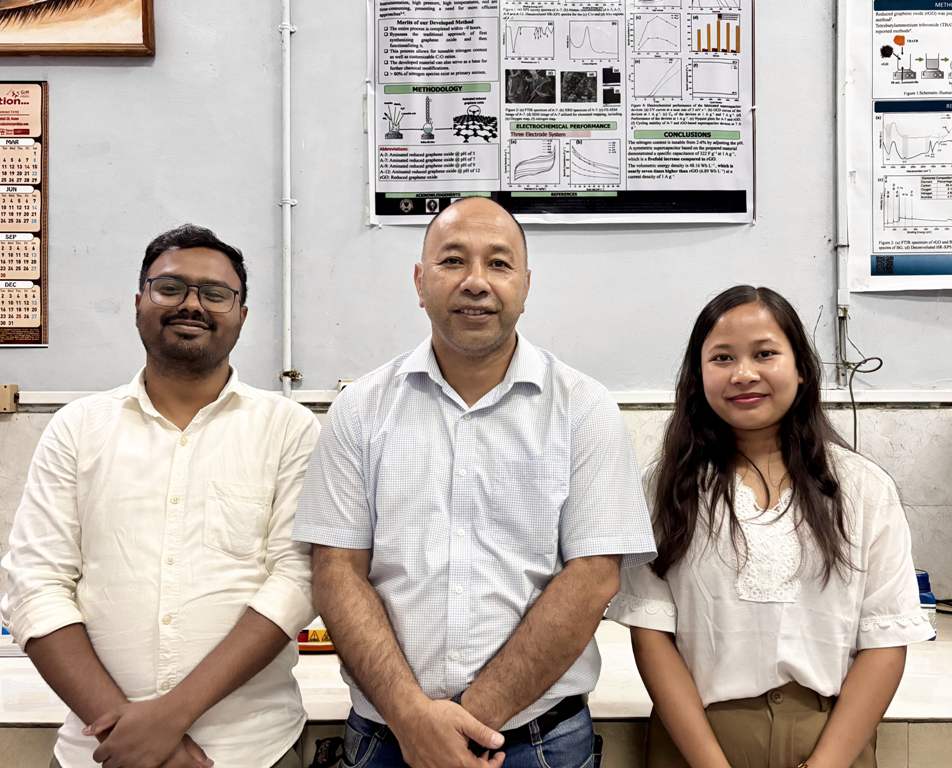WEDNESDAY, MAY 14, 2025
- Home
- Nagaland University-led team develops cheaper supercapacitor material
Nagaland University-led team develops cheaper supercapacitor material
Published on May 5, 2025
By EMN
Share

(L-R) Suraj Kumar, Prof. Dipak Sinha, and Priyakshi Bora.
- DIMAPUR — A multi-institute research team led by Nagaland University (NU) has claimed to have developed a cost-effective method to create an advanced material for building next-generation energy storage devices called ‘supercapacitors’.
- “They are gaining attention due to their ability to store large amounts of energy and charge very quickly, unlike traditional batteries,” a statement from the university said.
- Stating that these devices are being seen as a potential solution to the growing demand for more efficient and sustainable energy systems, it added that a critical part of a supercapacitor’s performance is the material used for its electrodes, and the high cost of such materials has been a barrier to widespread use.
- “This research aligns closely with India’s growing focus on clean energy and environmentally responsible technologies. In this context, the team developed a new approach to produce aminated graphene, a derivative of reduced graphene oxide.
Also read: Advisor Mannen lays fountain stone for Khutak Valley Organic Processing Plant
- “This method is notably cost-effective and faster, completing the entire procedure much more quickly than the traditional processes. Further, the obtained material also demonstrated good electrochemical properties. This kind of material can help improve the performance and lower the cost of energy storage systems. Initial lab tests have shown promising results. The research has already received an Indian patent. The research is now at a point where it can be taken further for possible commercial use,” it said.
- This research was taken up by a team comprising researchers from NU, Visvesvaraya Technological University (Karnataka), and Nagarjuna College of Engineering and Technology (Karnataka).
- They have developed a cost-effective method to produce high-performance ‘functionalised graphene’ supercapacitor material. It features a wide electrochemical window, good stability, and an impressive energy density.
- The study was conducted by Suraj Kumar, a DST-INSPIRE fellow at NU, working under the joint supervision of Prof. Dipak Sinha, Chemistry department, NU, and Prof. Dinesh Rangappa from Visvesvaraya Technological University.
- The team also included Priyakshi Bora from NU, Kunal Roy from Visvesvaraya Technological University, and Dr. Navya Rani M from Nagarjuna College of Engineering and Technology.
- The findings were published in iScience (doi.org/10.1016/j.isci.2025.112271), an open-access journal from Cell Press that provides a platform for original research in the life, physical, social, earth, social, and health sciences.
- Elaborating on this research, it was stated by Prof. Sinha that, unlike traditional methods, which are time-consuming and resource-intensive, the new approach operates under moderate temperature and pressure conditions, making it energy-efficient, faster, and more suitable for large-scale production.
- He further explained that the resulting material not only simplifies the manufacturing process but also delivers significantly enhanced performance. This enables a supercapacitor with a wide 2.2 V electrochemical window, an energy density exceeding 50 Wh/kg, and 98% energy retention after 10,000 cycles.
- Notably, it achieves a fivefold increase in gravimetric energy density compared to its non-aminated counterpart, demonstrating both scientific novelty and commercial potential.
- Elaborating further on the advantages of this new method, Suraj explained that traditional methods demand high temperatures, elevated pressures, and lengthy processing times, which add to the complexity and cost of production.
- According to him, conventional methods typically involve converting bulk graphite into graphene oxide, followed by a series of steps to reduce and functionalise it. In contrast, the developed process is a one-pot synthesis that directly transforms bulk graphite into aminated graphene.
- He maintained that this process not only reduces time and resource usage but also operates under moderate temperature and pressure, making it scalable and energy-efficient. Notably, it stands out as one of the quickest methods available for producing this material.

